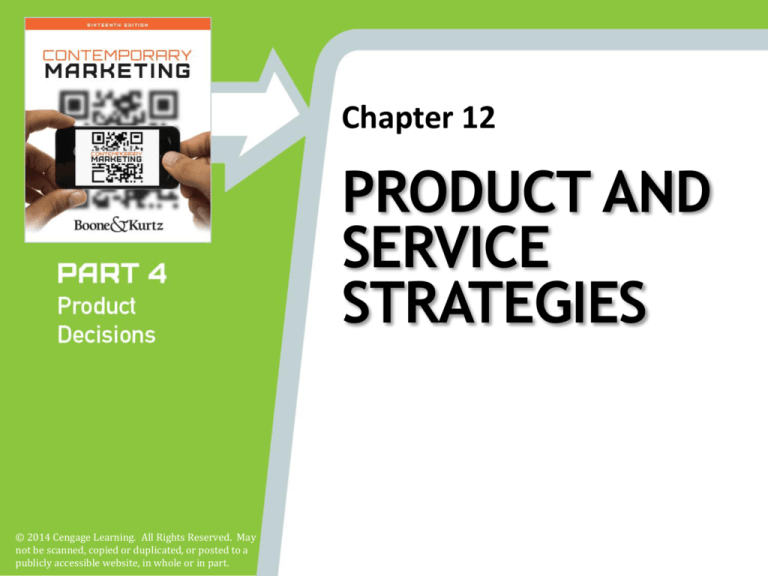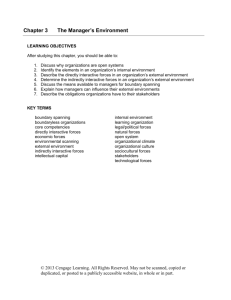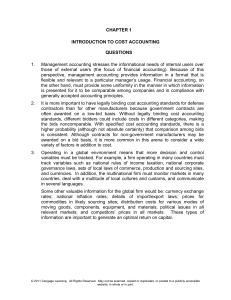
Chapter 12
PRODUCT AND
SERVICE
STRATEGIES
© 2014 Cengage Learning. All Rights Reserved. May
not be scanned, copied or duplicated, or posted to a
publicly accessible website, in whole or in part.
1
Chapter 12 Product and Service Strategies
Objectives
1. Define product, and distinguish between
goods and services and how they relate to
the goods-services continuum.
2. Outline the importance of the service
sector in today’s marketplace.
3. List the classifications of consumer goods
and services and briefly describe each
category.
© 2014 Cengage Learning. All Rights Reserved. May not be scanned, copied or duplicated, or posted to a publicly accessible website, in whole or in part.
2
Chapter 12 Product and Service Strategies
Objectives
4. Identify each of the types of business
goods and services.
5. Discuss how quality is used by marketers
as a product strategy.
6. Explain why firms develop lines of
related products.
7. Describe the way marketers typically
measure product mixes and make
product mix decisions.
© 2014 Cengage Learning. All Rights Reserved. May not be scanned, copied or duplicated, or posted to a publicly accessible website, in whole or in part.
3
Chapter 12 Product and Service Strategies
Objectives
8. Explain the concept of the product
lifecycle.
9. Discuss how a firm can extend a
product’s lifecycle, and explain why
certain products may be deleted.
© 2014 Cengage Learning. All Rights Reserved. May not be scanned, copied or duplicated, or posted to a publicly accessible website, in whole or in part.
4
Chapter 12 Product and Service Strategies
Marketing Mix
▮Blending of the four strategy elements—
product, distribution, promotion, and
price—to fit the needs and preferences of a
specific target market
▮Marketers develop strategies to sell both
tangible goods and intangible services
© 2014 Cengage Learning. All Rights Reserved. May not be scanned, copied or duplicated, or posted to a publicly accessible website, in whole or in part.
5
Chapter 12 Product and Service Strategies
What is a Product?
▮People buy want satisfaction, not objects
▮Product - Bundle of physical, service, and
symbolic attributes designed to satisfy a
customer’s wants and needs
© 2014 Cengage Learning. All Rights Reserved. May not be scanned, copied or duplicated, or posted to a publicly accessible website, in whole or in part.
6
Chapter 12 Product and Service Strategies
What are Goods and Services?
▮Services - Intangible tasks that satisfy the
needs of consumers and business users
▮Goods - Tangible products that customers
can see, hear, smell, taste, or touch
▮Goods–services continuum - Spectrum
along which goods and services fall
according to their attributes, from pure
good to pure service
© 2014 Cengage Learning. All Rights Reserved. May not be scanned, copied or duplicated, or posted to a publicly accessible website, in whole or in part.
7
Chapter 12 Product and Service Strategies
Figure 12.1 – Goods-Services Continuum
© 2014 Cengage Learning. All Rights Reserved. May not be scanned, copied or duplicated, or posted to a publicly accessible website, in whole or in part.
8
Chapter 12 Product and Service Strategies
Characteristics of Services
▮Intangible
▮Inseparable from the service providers
▮Perishable
▮Cannot be standardized
▮Buyers play important roles in the creation
and distribution of services
▮Wide variations in service standards
© 2014 Cengage Learning. All Rights Reserved. May not be scanned, copied or duplicated, or posted to a publicly accessible website, in whole or in part.
9
Chapter 12 Product and Service Strategies
Figure 12.2 – World’s Most Admired
Companies
© 2014 Cengage Learning. All Rights Reserved. May not be scanned, copied or duplicated, or posted to a publicly accessible website, in whole or in part.
10
Chapter 12 Product and Service Strategies
Importance of the Service Sector
▮The service sector makes up more than
three-fourths of the U.S. economy
▮Backshoring - Firms return much of their
offshore work to the U.S. to save money and
improve customer service efficiency
▮Homeshoring - Hiring workers to do jobs
from their homes
© 2014 Cengage Learning. All Rights Reserved. May not be scanned, copied or duplicated, or posted to a publicly accessible website, in whole or in part.
11
Chapter 12 Product and Service Strategies
Importance of the Service Sector
▮Most service firms emphasize marketing as
a significant activity for two reasons
• Growth potential of service transactions
represents a vast marketing opportunity
• Environment for services is changing
© 2014 Cengage Learning. All Rights Reserved. May not be scanned, copied or duplicated, or posted to a publicly accessible website, in whole or in part.
12
Chapter 12 Product and Service Strategies
Classifying Goods and Services for
Consumer and Business Markets
▮Consumer (B2C) products - Product
destined for use by ultimate consumers
▮Business (B2B) products - Product that
contributes directly or indirectly to the
output of other products for resale; also
called industrial or organizational product
▮Some products fall into both categories
© 2014 Cengage Learning. All Rights Reserved. May not be scanned, copied or duplicated, or posted to a publicly accessible website, in whole or in part.
13
Chapter 12 Product and Service Strategies
Figure 12.3 – Classification of Consumer
Products
© 2014 Cengage Learning. All Rights Reserved. May not be scanned, copied or duplicated, or posted to a publicly accessible website, in whole or in part.
14
Chapter 12 Product and Service Strategies
Classifying Consumer Services
▮Marketers rely on five questions to classify
services
• What is the nature of the service?
• What type of relationship does the service
organization have with its customers?
© 2014 Cengage Learning. All Rights Reserved. May not be scanned, copied or duplicated, or posted to a publicly accessible website, in whole or in part.
15
Chapter 12 Product and Service Strategies
Classifying Consumer Services
• How much flexibility is there for customization
and judgment on the part of the service
provider?
• Do demand and supply for the service fluctuate?
• How is the service delivered?
© 2014 Cengage Learning. All Rights Reserved. May not be scanned, copied or duplicated, or posted to a publicly accessible website, in whole or in part.
16
Chapter 12 Product and Service Strategies
Applying the Consumer Products
Classification System
▮Classification system poses a few problems
• Obstacle to implementing this system results
from the suggestion that all goods and services
must fit within one of the three categories:
• Convenience goods
• Shopping goods
• Specialty goods
• Problem emerges because consumers differ in
their buying patterns
© 2014 Cengage Learning. All Rights Reserved. May not be scanned, copied or duplicated, or posted to a publicly accessible website, in whole or in part.
17
Chapter 12 Product and Service Strategies
Table 12.1 – Marketing Impact of the
Consumer Products Classification System
© 2014 Cengage Learning. All Rights Reserved. May not be scanned, copied or duplicated, or posted to a publicly accessible website, in whole or in part.
18
Chapter 12 Product and Service Strategies
Figure 12.4 – Classification of Business
Products
© 2014 Cengage Learning. All Rights Reserved. May not be scanned, copied or duplicated, or posted to a publicly accessible website, in whole or in part.
19
Chapter 12 Product and Service Strategies
Table 12.2 – Marketing Impact of the
Business Products Classification System
© 2014 Cengage Learning. All Rights Reserved. May not be scanned, copied or duplicated, or posted to a publicly accessible website, in whole or in part.
20
Chapter 12 Product and Service Strategies
Quality as a Product Strategy
▮Quality is a key component to a firm’s
success in a competitive marketplace
▮Total quality management (TQM) Continuous effort to improve products and
work processes with the goal of achieving
customer satisfaction and world-class
performance
© 2014 Cengage Learning. All Rights Reserved. May not be scanned, copied or duplicated, or posted to a publicly accessible website, in whole or in part.
21
Chapter 12 Product and Service Strategies
Worldwide Quality Programs
▮In the 1980s, the quality revolution picked
up speed in U.S. corporations
▮The goal was to better compete with
Japanese manufacturers
▮The U.S. Congress established the Malcolm
Baldrige National Quality Award to
recognize excellence in quality management
© 2014 Cengage Learning. All Rights Reserved. May not be scanned, copied or duplicated, or posted to a publicly accessible website, in whole or in part.
22
Chapter 12 Product and Service Strategies
Worldwide Quality Programs
▮ISO 9001:2008 standards implemented by
the European Union define international,
generic criteria for quality management and
assurance
▮The U.S. member body of ISO is the National
Institute of Standards and Technology
© 2014 Cengage Learning. All Rights Reserved. May not be scanned, copied or duplicated, or posted to a publicly accessible website, in whole or in part.
23
Chapter 12 Product and Service Strategies
Benchmarking
▮Measuring quality by comparing
performance against industry leaders
▮Involves three main activities
• Identifying manufacturing or business
processes that need improvement
• Comparing internal processes to those of
industry leaders
• Implementing changes for quality improvement
© 2014 Cengage Learning. All Rights Reserved. May not be scanned, copied or duplicated, or posted to a publicly accessible website, in whole or in part.
24
Chapter 12 Product and Service Strategies
Benchmarking
▮Requires two types of analyses: internal and
external
• Company must first analyze its own activities to
determine strengths and weaknesses
• External analysis involves gathering
information about the benchmark partner, to
find out why the partner is perceived as the
industry’s best
© 2014 Cengage Learning. All Rights Reserved. May not be scanned, copied or duplicated, or posted to a publicly accessible website, in whole or in part.
25
Chapter 12 Product and Service Strategies
Quality of Services
▮Service encounter - Point at which the
customer and service provider interact
▮Service quality - Expected and perceived
quality of a service offering
© 2014 Cengage Learning. All Rights Reserved. May not be scanned, copied or duplicated, or posted to a publicly accessible website, in whole or in part.
26
Chapter 12 Product and Service Strategies
Quality of Services
▮Determined by five variables
•
•
•
•
•
Tangibles
Reliability
Responsiveness
Assurances
Empathy
© 2014 Cengage Learning. All Rights Reserved. May not be scanned, copied or duplicated, or posted to a publicly accessible website, in whole or in part.
27
Chapter 12 Product and Service Strategies
Development of Product Lines
▮Product line - Series of related products
▮Desire to grow
• Growth potential is limited if a company focuses
on a single product
© 2014 Cengage Learning. All Rights Reserved. May not be scanned, copied or duplicated, or posted to a publicly accessible website, in whole or in part.
28
Chapter 12 Product and Service Strategies
Enhancing the Company’s Market Position
▮Entire lines of products make a company
more important to consumers and
marketing intermediaries
▮Servicing the variety of products a company
sells can enhance its position in the market
© 2014 Cengage Learning. All Rights Reserved. May not be scanned, copied or duplicated, or posted to a publicly accessible website, in whole or in part.
29
Chapter 12 Product and Service Strategies
Optimal Use of Company Resources
▮Spreading operations costs over a series of
product lines reduces the average
production and marketing costs of each
product
© 2014 Cengage Learning. All Rights Reserved. May not be scanned, copied or duplicated, or posted to a publicly accessible website, in whole or in part.
30
Chapter 12 Product and Service Strategies
The Product Mix
▮Assortment of product lines and individual
product offerings
▮Product mix width
• Number of product lines a firm offers
▮Product mix length
• Number of different products a firm sells
▮Product mix depth
• Variations in each product that the firm
markets
© 2014 Cengage Learning. All Rights Reserved. May not be scanned, copied or duplicated, or posted to a publicly accessible website, in whole or in part.
31
Chapter 12 Product and Service Strategies
Product Mix Decisions
▮To evaluate a firm’s product mix, marketers
look at the effectiveness of its depth, length,
and width
▮Firms may decide to add to their mixes by
purchasing product lines from other
companies
▮Line extension - Development of individual
offerings that appeal to different market
segments while remaining closely related
to the existing product line
© 2014 Cengage Learning. All Rights Reserved. May not be scanned, copied or duplicated, or posted to a publicly accessible website, in whole or in part.
32
Chapter 12 Product and Service Strategies
Figure 12.5 – Stages in the Product
Lifecycle
© 2014 Cengage Learning. All Rights Reserved. May not be scanned, copied or duplicated, or posted to a publicly accessible website, in whole or in part.
33
Chapter 12 Product and Service Strategies
The Product Lifecycle
▮Introductory stage
• Products in this stage might bring new
technology to a product category
• Technical problems and financial losses are
common
▮Growth stage
• Sales volume rises rapidly as new customers
make initial purchases and early buyers
repurchase the product
© 2014 Cengage Learning. All Rights Reserved. May not be scanned, copied or duplicated, or posted to a publicly accessible website, in whole or in part.
34
Chapter 12 Product and Service Strategies
The Product Lifecycle
▮Maturity stage
• Sales of a product category continue to grow
during the early part of this stage but eventually
reach a plateau as the backlog of potential
customers dwindles
▮Decline stage
• Innovations or shifts in consumer preferences
bring about an absolute decline in industry
sales
© 2014 Cengage Learning. All Rights Reserved. May not be scanned, copied or duplicated, or posted to a publicly accessible website, in whole or in part.
35
Chapter 12 Product and Service Strategies
Extending the Product Lifecycle
▮Increasing frequency of use
• Convincing current customers to buy a product
more frequently boosts total sales even if no
new buyers enter the market
▮Increasing the number of users
• Attracting new customers who have not
previously used the product
© 2014 Cengage Learning. All Rights Reserved. May not be scanned, copied or duplicated, or posted to a publicly accessible website, in whole or in part.
36
Chapter 12 Product and Service Strategies
Extending the Product Lifecycle
▮Finding new uses
• New applications extend a product’s lifecycle
▮Changing package sizes, labels, or product
quality
• New packaging and labels with updated images
and slogans can help revitalize a product
© 2014 Cengage Learning. All Rights Reserved. May not be scanned, copied or duplicated, or posted to a publicly accessible website, in whole or in part.
37
Chapter 12 Product and Service Strategies
Product Deletion Decisions
▮Marketers prune product lines and
eliminate marginal products to preserve
limited resources
▮Firms may carry unprofitable items to carry
a complete product line
▮Shortages or raw materials can prompt a
firm to discontinue production
▮Firm may drop products that don’t fit into
the direction in which it plans to grow
© 2014 Cengage Learning. All Rights Reserved. May not be scanned, copied or duplicated, or posted to a publicly accessible website, in whole or in part.
38
Chapter 12 Product and Service Strategies
BoltBus Video
http://www.cengage.com/marketing/book_content/boone_9781133628460
/videos/ch12.html
© 2014 Cengage Learning. All Rights Reserved. May not be scanned, copied or duplicated, or posted to a publicly accessible website, in whole or in part.
39









